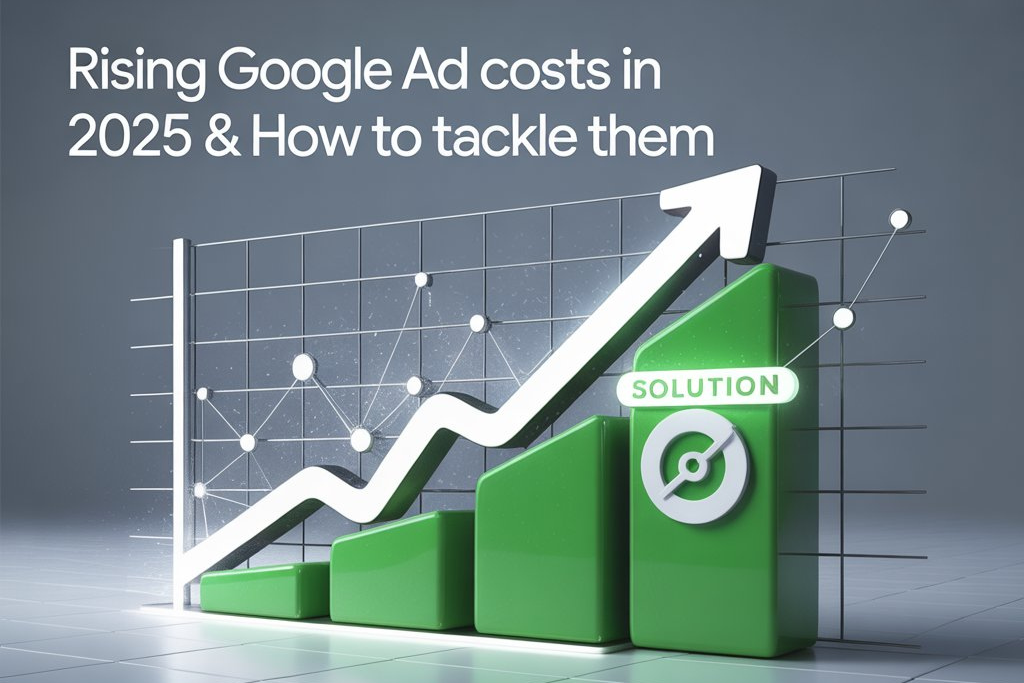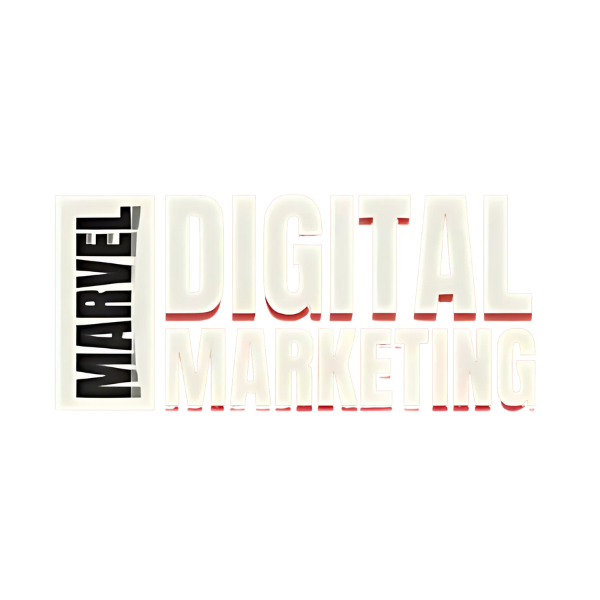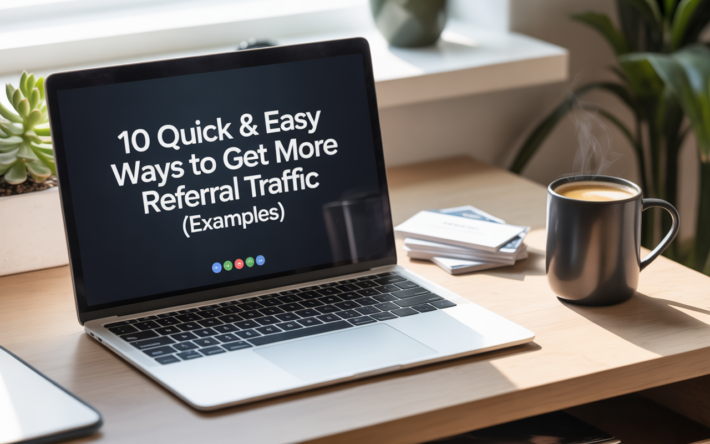Rising Google Ad Costs in 2025 & How to Tackle Them

The rising Google ad costs in 2025 are making headlines across the digital marketing world, and for good reason. Cost-per-click (CPC) and cost-per-lead (CPL) rates have reached unprecedented levels, with average CPCs increasing by over 18% year-over-year, according to a recent WordStream report. This surge is reshaping how brands approach their paid advertising strategies.
Industries like education, SaaS, healthcare, and finance are among the hardest hit. For example, the average CPC in the education sector has climbed to ₹60–₹75 per click, while SaaS companies are now paying upwards of ₹150 per click, depending on keyword competitiveness.
In the healthcare space, compliance and trust factors have driven up lead costs to over ₹2,500, and finance sees similar spikes due to high-value conversions.
These numbers aren’t just stats—they’re wake-up calls. For many businesses, especially startups or SMEs, the rising Google ad costs in 2025 are making traditional ad campaigns less sustainable. It’s no longer enough to just “set it and forget it.”
To stay competitive, marketers must adapt with smarter targeting, better creative, and diversified ad platforms. Investing in conversion rate optimization (CRO), leveraging AI-driven ad automation, and exploring organic alternatives like SEO and influencer partnerships are no longer optional—they’re essential.
Also Read : 6 Smart Ways to Reduce Google Ads CPC & Maximize Budget
The Core Drivers Behind Rising Google Ad Costs in 2025

As we step deeper into 2025, marketers across industries are grappling with a hard truth: Rising Google Ad Costs in 2025 are no longer a trend—they’re the new reality. From shrinking organic reach to advanced AI automation, a mix of forces is pushing CPCs (cost-per-click) through the roof. Here’s what’s fueling this surge and what it means for your marketing budget.
a. AI-Powered Search and Reduced Organic Visibility
One of the biggest disruptors this year has been the rollout of AI tools like Google Gemini, which provide direct answers on search result pages. While this makes user experience seamless, it drastically reduces the number of people clicking on organic results. A recent study by SparkToro shows that over 65% of Google searches in 2025 now end without a single click—a phenomenon known as “zero-click searches.”
As a result, businesses are turning to paid ads to maintain visibility. This shift is one of the main reasons behind the Rising Google Ad Costs in 2025, with some sectors seeing a 30% to 100% increase in CPCs compared to last year.
b. Intensified Competition and Auction Dynamics
With organic reach plummeting, more advertisers are entering Google’s ad auctions than ever before. Whether you’re a startup or a Fortune 500 company, you’re now battling in a much tighter space.
Industries like BFSI (Banking, Financial Services, and Insurance), healthcare, and retail have seen the sharpest spikes. According to WordStream, the average CPC in healthcare jumped from $2.60 in 2023 to $4.90 in 2025—nearly a 90% increase. Bidding wars have become the norm, further inflating prices.
c. AI-Driven Bidding and Automation
Google’s Smart Bidding and Performance Max campaigns have revolutionized ad targeting—but not without a cost. These tools use machine learning to optimize bids in real-time, making campaigns more efficient but also more competitive.
As more brands adopt automation, the competition becomes algorithm vs. algorithm. This dynamic directly contributes to Rising Google Ad Costs in 2025, especially as the platforms encourage higher bids for better placements. While these tools promise better ROI, they also require higher upfront investment to stay visible.
d. Regulatory Pressures and Antitrust Actions
The legal spotlight on Google has intensified, with ongoing antitrust trials and regulatory probes shaking up the ad landscape. In response, Google is experimenting with changes that could affect everything from how ads are served to how pricing is determined.
These pressures may eventually open the market to more competitors, but in the short term, they’re adding uncertainty and volatility—two factors that rarely favor lower ad costs. For now, they’re yet another contributor to the Rising Google Ad Costs in 2025.
As a digital marketing marvel navigating this evolving ecosystem, your strategy needs to evolve just as fast. Budget wisely, diversify your channels, and most importantly—don’t rely on paid ads alone. The cost of visibility has never been higher, but with the right insights, your brand can still rise above the noise.
Also Read : 2025 Google Ads Benchmarks: Industry Trends & Insights
Industry-Specific Impacts of Rising Google Ad Costs

The Rising Google Ad Costs in 2025 are reshaping how industries approach digital advertising. As competition intensifies and algorithms evolve, the cost to acquire leads or visibility on Google is no longer what it used to be. Here’s how different sectors are being affected:
a. Education Sector
The education industry is facing an uphill battle as Cost-Per-Leads (CPLs) have surged by up to 100%. With more ed-tech platforms, coaching centers, and global universities going digital, the competition for the same set of keywords has become fierce.
Moreover, Google’s AI-driven search updates now prioritize more personalized and in-depth content, making traditional keyword stuffing obsolete. Institutions are now forced to double their ad budgets just to maintain last year’s lead volumes—a real pinch for smaller players.
b. SaaS and B2B Services
In the B2B space, the Rising Google Ad Costs in 2025 have led to a 35%–50% increase in lead generation costs. SaaS companies, which often rely on paid ads for customer acquisition, are now revisiting their entire keyword strategies. Long-tail keywords and intent-driven targeting have become essential to stay profitable.
What used to cost $80 per lead may now cost well over $120, and that’s assuming the click converts. This inflation is pushing companies to blend SEO, content marketing, and account-based marketing into their paid ad strategies.
c. Healthcare and Finance
Two of the most competitive and compliance-heavy industries—healthcare and finance—are experiencing unprecedented ad inflation. High-intent keywords in these sectors now cost over $10–$15 per click, making mistakes more expensive than ever.
For example, “emergency loan” or “urgent care near me” can quickly eat through a daily ad budget in hours. As trust and credibility remain key in these sectors, advertisers must now pair high CPC bids with flawless landing page experiences and strong remarketing efforts to ensure ROI.
No matter the industry, the Rising Google Ad Costs in 2025 are a wake-up call for marketers. This is not just inflation—it’s a digital marketing marvel that’s rewriting playbooks. Brands must innovate or risk falling behind in this new pay-to-play ecosystem.
Also Read : Digital Marketing Marvel: How to Lower Your Google Ads Cost and Maximize ROI in 2025
Strategic Responses to Mitigate Rising Ad Costs

The challenge of rising Google Ad costs in 2025 is prompting marketers to rethink their advertising strategies more creatively and strategically. With average Cost Per Click (CPC) on Google Ads expected to increase by up to 15-20% this year, diversifying your approach has become essential to maintain ROI.
a. Diversification of Advertising Channels
Over-reliance on Google Ads amid these rising costs can strain marketing budgets. Platforms like TikTok, LinkedIn, and programmatic advertising offer cost-effective alternatives and often provide higher engagement rates in niche segments.
For example, LinkedIn CPC tends to be more stable, and TikTok’s ad platform has seen a surge in user engagement, especially among younger demographics, often delivering lower CPC compared to Google.
Investing in owned channels such as email and SMS marketing further reduces dependence on paid ads. According to a 2024 DMA report, email marketing yields an average ROI of $36 for every $1 spent, making it a powerful tool to nurture leads without the unpredictability of ad auction prices.
b. Leveraging First-Party Data
With Google’s tightening privacy regulations, first-party data has become gold. Collecting data directly through lead magnets or loyalty programs allows businesses to create highly personalized campaigns. Using Customer Data Platforms (CDPs), companies can unify this data to target audiences more effectively — a tactic proven to boost conversion rates by 20-30%.
This approach not only counterbalances the impact of rising Google Ad costs in 2025 but also builds long-term customer relationships beyond ad spend fluctuations.
c. Embracing AI and Automation Wisely
AI-powered tools can be a marketer’s best friend amid increasing ad costs. Bid adjustment algorithms and predictive analytics help optimize spend by identifying the best times, audiences, and keywords to target. However, blind reliance on automation can backfire, leading to overspending.
Successful marketers blend AI with manual oversight, continuously monitoring campaigns to balance efficiency and control — a necessary tactic in light of the rising Google Ad costs in 2025 landscape.
d. Enhancing Ad Quality and Relevance
Improving Google Ads Quality Scores can significantly lower CPCs and improve ad placement. Focusing on relevant keywords, compelling ad copy, and tightly aligned landing pages can boost conversion rates by up to 50%, according to Google’s own data.
In 2025, when ad costs are climbing, these refinements become not just good practice but crucial survival tactics to stretch every advertising dollar.
This strategic roadmap arms marketers with actionable steps to navigate the rising Google Ad costs in 2025 without sacrificing campaign performance — a true Digital Marketing Marvel approach.
Also Read : What is a Good Google Ads Quality Score?
The Future Outlook: Navigating the Evolving Digital Advertising Landscape

As we look ahead, the rising Google ad costs in 2025 are expected to continue their upward trend, pushing marketers to rethink their strategies. According to recent industry reports, Google Ads costs have already increased by an average of 15-20% year-over-year, and experts predict this trajectory will persist. This makes it crucial for brands to adopt more adaptive and efficient approaches to maximize their advertising ROI.
One key strategy is focusing on building authentic brand narratives and fostering community engagement. In an age where consumers crave genuine connections, brands that tell compelling stories and create meaningful interactions can stand out despite higher ad expenses.
For example, brands leveraging user-generated content and transparent communication tend to experience stronger loyalty, which can reduce reliance on costly paid ads over time.
Moreover, staying informed about regulatory changes—such as privacy laws—and technological advancements like AI-driven targeting will be essential to remain competitive. With Google continually updating its algorithms and policies, marketers must be agile and proactive in adapting their campaigns.
Embracing new tools and strategies will not only help mitigate the impact of rising Google ad costs in 2025 but also unlock fresh opportunities for growth.
Ultimately, navigating the evolving digital advertising landscape requires a blend of creativity, data-driven insights, and a deep understanding of audience needs. Brands that successfully integrate these elements will thrive even as ad costs climb.
Also Read : What is a Good Cost Per Click (CPC)
Conclusion
The landscape of digital advertising is shifting dramatically, with the Rising Google Ad Costs in 2025 driven by increasing competition, evolving consumer behavior, and stricter privacy regulations. Data shows that average cost-per-click (CPC) rates have surged by over 15% compared to 2024, reflecting how advertisers are bidding more aggressively for limited ad space.
In this environment, embracing strategic diversification beyond Google Ads, leveraging advanced data analytics, and committing to continuous campaign optimization are no longer optional—they are essential. Marketers who rely solely on traditional tactics risk seeing diminishing returns as ad costs escalate.
As a digital marketing marvel, the key to sustaining ROI amid these rising costs lies in proactive adaptation.
Businesses that pivot quickly, experiment with alternative channels, and harness data insights will not only survive but thrive in 2025’s evolving advertising ecosystem. Staying informed and agile will be your greatest assets against the tide of Rising Google Ad Costs in 2025.


